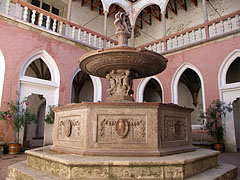(为小屏幕设备进优化)

Visegrád
City that is embraced
City that is embraced
by hills and the Danube
by hills and the Danube
With its marvellous castle and palace this city used to be Hungary’s royal seat until it was replaced by Buda. Several of our great kings, great events and great legends are connected with Visegrád. The view from the castle is still the same as it was in the times of our kings – the Pilis and Börzsöny mountain chains and the winding Danube under the castle.

In Roman times a fortification already stood on Sibrik Hill, but the ruins of a military camp and a Roman villa have also been found here. The name of Visegrád has Slav origins and it means a castle built on a hill.
Prince Géza realised that the southern gate needed to be fortified in order to protect Esztergom, the royal seat. This was when Visegrád became an overseer’s seat. After a while it also became a royal seat. The Turks later invaded it. In 1686, after the hundred and fifty year long Turkish occupation, the completeley depopulated settlement was peopled with Germans.
Citadel (Upper Castle)
This is Hungary’s most beautiful and best preserved medieval castle. After the first Mongol invasion in the 13th century Béla IV and his wife Lascaris Maria from Byzantium launched the construction of the castle, subsidised by the jewellery of her dowry. The purpose of this plan was to establish a place which could protect their daughter, Margaret, and the inhabitants of the area in case of a hostile attack.

Margaret lived in a Dominican monastery on the Island of Rabbits, which is now called Margaret Island. Becasue of the miracles made during her life and the wonderful cures connected to her grave she later became one of Hungary’s greatest saints.

The castle itself was triangular with two towers. One of the gate towers was overlooking Buda and the other, the old tower, protected the castle against attacks coming from the north. The chapel was located in the old tower and it was consecrated to Saint Elizabeth of the Árpád dynasty.
Charles I seized the castle in the 14th century and made this his royal seat, instead of Temesvár, which is now in Romania. The Saint Crown was brought here form Fehérvár during this time, and it was kept in Visegrád for almost two centuries. Furthermore the Polish crown and crown jewels were also kept within its walls for more than forty years.

From the year 1526 onwards Turkish attacks devastated the castle. For a long time it was their property and during which much of it got destroyed. But the worst damage came in 1702 when Leopold I, Austrian Kaiser, blew it up.
The Lower castle and Salamon Tower
The Lower castle and the Citadel was connected with a wall closing the valley. Two watchtowers and a gate tower were located on it. The rebel Salamon was kept in captivitiy in Visegrád on the command of St Ladislaus, and the fortified building got its name after this event in the 13th century. It is true that the tower was named after King Salamon, but in fact he was not kept here, but in the overseer’s castle on Sibrik Hill.

Salamon Tower is a six-floored, hexagonal building which was connected to the lower bastion with a strong wall. Its lower part was used both for military and agricultural purposes, while the upper part served as living quarters.
Royal Palace
It was constructed for one reason, namely that the Citadel and the Lower Castle proved to be too small, so to replace them a spacious and Italian-like palace was built. The two-styled, Renaissance and late-Gothic, palace became the official seat of the Hungarian rulers until Sigismund transferred it to Buda.

The building was renovated during the reign of Matthias Corvinus, when he converted it into a summer residence. He did not really stay in the Citadel, but in these beautiful surroundings, where he organised magnificent dinners and hunts. According to a story the palace was so splendid that the envoy of the Turkish emperor on seeing it was so overcome he just kept repeating ’The emperor is greeting you’.
Roman fortification on Sibrik Hill, Castrum
This triangular military camp was constructed during the reign of Constantinus I. In those times it was a significant protective fortification. Its gate tower, overlooking the Danube, guarded the old road against barbarian attacks. In the 4th century the Roman garrison left and German Quadi tribes settled here. Their dwellings, holes dug into the ground, can still be seen.
特性,特征
类型:
城镇,市镇,乡镇
位置:
欧洲(大陆) > 匈牙利(国家) > 布達佩斯及其周邊(旅游区) > Pest megye (county)(州,县) > Danube Bend (Dunakanyar)(地理区域)
GPS坐标的: 纬度 47°46'47",经度 18°58'57" (N47 46.78 - E18 58.95)
Visegrád - 影集,的照片,图像画廊(220张照片 / 4画廊)
Visegrád - 全景图像(1张照片)
您可能也有兴趣(相关网页):
目的地在旅遊指南:
Visegrád(220张照片 + 1全景图像)
Danube Bend (Dunakanyar)(1,769张照片 + 6全景图像)
Pest megye (county)(15,122张照片 + 50全景图像)
布達佩斯及其周邊(15,989张照片 + 52全景图像)
匈牙利(27,287张照片 + 163全景图像)
并且还:
(在这里:Pest megye和Danube Bend)
Pilis Mountains (Pilis hegység)(335张照片)
Buda Hills (Budai-hegység)(8,632张照片 + 21全景图像)
Gödöllő Hills (Gödöllői-dombság)(4,203张照片 + 21全景图像)
Visegrád Mountains (Visegrádi-hegység)(116张照片 + 1全景图像)
Cegléd(125张照片 + 2全景图像)
Ráckeve(92张照片)
Dunakeszi(259张照片)
Göd(23张照片)
Nagykőrös(250张照片 + 2全景图像)
Nagymaros(31张照片)
Pilisvörösvár(88张照片)
Szentendre(597张照片 + 1全景图像)
Vác(232张照片 + 2全景图像)
Esztergom(110张照片 + 1全景图像)
Dunakeszi(259张照片)
Göd(23张照片)
Nagymaros(31张照片)
Szentendre(597张照片 + 1全景图像)
Vác(232张照片 + 2全景图像)
Csővár(105张照片)
Kóspallag(53张照片)
Márianosztra(37张照片)
Nagybörzsöny(4张照片)
Pilisszentkereszt(122张照片)
Nógrád(181张照片)
Zsámbék
这里每全景照片:
Visegrád(1张照片)
Danube Bend (Dunakanyar)(6张照片)
Pest megye (county)(50张照片)
布達佩斯及其周邊(52张照片)
匈牙利(163张照片)
欧洲(165张照片)
每一个正常的照片在这里:
Visegrád(220张照片 / 4画廊)
Danube Bend (Dunakanyar)(1,769张照片 / 31画廊)
Pest megye (county)(15,122张照片 / 221画廊)
布達佩斯及其周邊(15,989张照片 / 234画廊)
匈牙利(27,287张照片 / 462画廊)
欧洲(30,494张照片 / 523画廊)
与你的朋友分享!
等等























